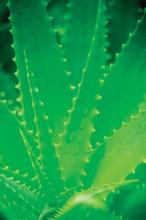Although hydroquinone has long been the standard skin-whitening agent throughout the world, its reputed cytotoxicity prompted a ban in 2000 in Europe and strict regulation in Asia. In response, in addition to combination treatments that include but rely less on hydroquinone, the armamentarium has expanded to include a wide range of active constituents extracted from plants, including aloesin, arbutin, flavonoids, gentisic acid, hesperidin, licorice, niacinamide, yeast derivatives, and polyphenols, which inhibit melanogenesis through varying mechanisms without inducing melanocytotoxicity (J. Investig. Dermatol. Symp. Proc. 2008;13:20-4). This column will focus on recent research related to the skin-lightening activity of aloesin.
A moderately high-molecular-weight C-glycosylated chromone naturally derived and isolated from aloe vera, aloesin has been found to dose-dependently inhibit tyrosinase by blocking both the hydroxylation of tyrosine to 3,4-dihydroxyphenylalanine (DOPA) and oxidation of DOPA to dopaquinone, as well as melanin production in cultured normal melanocytes (Pigment Cell. Res. 2002;15:335-40). Notably, aloesin (2-acetonyl-8-beta-D-glucopyranosyl-7-hydroxy-5-methylchromone), which is difficult to synthesize, and a few chemically related chromones, particularly the 5-methyl-7-methoxy-2(2´-benzyl-3´-oxobutyl)-chromone, have been shown to display a more potent inhibitory effect on tyrosinase than arbutin and kojic acid (Dermatol. Clin. 2007;25:353-62; Chem. Pharm. Bull. [Tokyo] 2002;50:309-11; Pigment Cell Res. 2006;19:550-71). The activity of aloesin in relationship to tyrosinase is important because tyrosinase is the rate-limiting enzyme in melanin production, and thus directly impacts skin pigment formation.
Skin-Lightening Properties
Even though aloesin appears to be an important component in the armamentarium against hyperpigmentation disorders, its hydrophilic nature renders it less able than hydroquinone to penetrate the skin (Dermatol. Ther. 2007;20:308-13). However, some believe that its slower penetration of the skin endows aloesin with greater potential as a skin-lightening agent for cosmetic purposes (Pigment. Cell. Res. 2006;19:550-71).
Although less effective than hydroquinone when used as single therapy, aloesin is safer, and has been most successfully used in hypopigmenting regimens for its syngergistic activity in combination therapies with two or more agents acting on various mechanisms (Pigment. Cell. Res. 2006;19:550-71). In 1999, aloesin and arbutin were shown to act synergistically in suppressing tyrosinase activity, and thus melanin production, in a combined treatment, but through different mechanisms. Aloesin inhibited tyrosinase activity noncompetitively whereas arbutin acted competitively (Arch. Pharm. Res. 1999;22:232-6).
Another good example comes from a 2002 examination of the inhibitory effects of aloesin, arbutin, and a combination of the two agents. Human subjects were exposed to UV radiation on the inner forearm, and the treated areas were assigned to four daily treatments for 15 days with vehicle control, aloesin, arbutin, and a combination of aloesin and arbutin. Aloesin blocked pigmentation by 34%, arbutin by 43.5%, and the combination treatment by 63.3%, compared with the control. In addition, investigators noted that aloesin dose-dependently inhibited UV-induced pigmentation and concluded that the compound may be a suitable agent for blocking UV-induced melanin formation (Clin. Exp. Dermatol. 2002;27:513-5). In 2004, Yang et al. also investigated the synergistic effects of aloesin and arbutin. They treated normal cultured human melanocytes in vitro with an aloesin and arbutin mixture, which was found to have suppressed tyrosinase activity and resulted in a significant decline in melanin content in the cultured melanocytes. The mixture had little effect on melanocyte viability (Zhonghua Zheng Xing Wai Ke Za Zhi 2004;20:369-71).
Melanogenesis Properties
In 2008, most of the same investigators, led this time by Wang, examined the effects of aloesin on melanogenesis in an in vitro pigmented skin equivalent, given recent success in the study of skin metabolism and depigmenting agents in such models, which have been shown to display similar morphologic and growth qualities to human skin. The investigators found that aloesin exhibited direct inhibitory effects on melanogenesis, and dose-dependently sparked a decline in tyrosinase activity and melanin content. Arbutin also exhibited dose-dependent inhibitory activity, but was less effective than aloesin. Tea polyphenols demonstrated greater inhibitory activity than aloesin. Nevertheless, the authors concluded that aloesin evinced potential as an agent intended to affect pigmentation for cosmetic or therapeutic purposes (Int. J. Cosmet. Sci. 2008;30:121-30).
Previously, in 2002, Jones et al. demonstrated that aloesin modulates melanogenesis by competitively inhibiting tyrosinase at the dihydroxyphenylalanine oxidation site, suppressing melanin synthesis in vitro, and that it is a tyrosinase inhibitor from mushroom, human, and murine sources. They also found that aloesin dose-dependently inhibited tyrosine hydroxylase and DOPA oxidase activities of tyrosinase from normal human melanocyte cell lysates. The researchers concluded that aloesin indeed demonstrated potential as a cosmetic or therapeutic agent for altering skin pigmentation (Pigment. Cell. Res. 2002;15:335-40).


